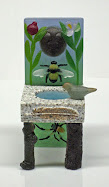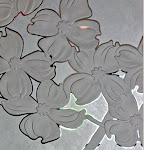
Time for another installment of ‘how I became a glass artist’. You can read them all in sequential order here but you have to read from the bottom up.
Back in the early 80s there was a lot of oil money around and the oil companies were good clients as were the country clubs and racquet clubs. We were doing well enough by that time to put the kids in a preschool program for half a day and take on a part time employee. By 1983, we needed to expand our work space so we rented a building three blocks away. It was an old grocery store that had been vacant for some time. It was really a great space though, glass across the front with very high ceilings and high windows along the sides with an apartment upstairs that we used for office space and a conference room. It’s also where we parked the kids in the afternoon while we were working downstairs. We rented part of the space to a stained glass worker (not our friend Gene who had his own studio) and in ‘84, a glass blower joined us. He built a small furnace in the back space behind a wall so for a while, we had quite a little glass art center going.
Our part-timer had quit soon after we moved into the building but one day a guy walked in looking for a job. He was currently working for his uncle who was one of our competitors. We weren’t actually looking for an employee at that time but his etching skills were pretty good so we agreed to a couple of weeks and he ended up working for us for about 8 or 9 years. He eventually did all the sandblasting.
It was also during this time that we learned to cast glass. We had been seeing pictures of Lalique’s cast architectural work and I was enamored of it, plus we were getting interested in doing carved glass art pieces and we thought a good shortcut would be to cast the base forms and then carve them. To this end, Marc went to Lubbock for a casting workshop put on by Kent Ipsen. They never cast a single piece of glass, in fact, spent the whole week building a kiln which didn’t even get finished, but Marc came back with enough knowledge to start us on our way. He built a kiln out of an old refrigerator and I sold a job for Marathon Oil incorporating cast glass forms.









The 80s sure were something - unfortunately it's when I was coming of age & I incorporated all the commercialism values into my spending habits.
ReplyDeleteThe new font is kind of small - it reads ok, but could stand to be a little bigger.
I'm reading this with fascination. In town, we have a few glass artists; a couple, The Hawthornes, work and live here, but they have a gallery in Big Sur. This is no sissy work at all; it takes stamina, talent, and a lot of savvy in marketing. I'm happy to learn about your journey. Glad to know that your business is growing still.
ReplyDeletep.s. only an artist would indulge us with different fonts! Lovely.
ReplyDeleteSo interesting! I need to go back and read the whole series. I have so many question for you regarding working with glass. I'll read first though... you may address my questions in you other posts.
ReplyDeleteIt's wonderful how you've made a life of this; I'd imagine the knowledge you have working with glass is top-shelf. Very nice.
ReplyDeleteheady times that carried many artists through what would otherwise be lean pickings. i love the dynamic feeling of your experience . . . people and ideas coming and going. my own art career was in full flower through that period as an artist and as a musician. people write off the eighties as fluffy but they are distracted by the skin of the times. the heart and certainly the soul of the times was much different/richer i think. have a peaceful evening. steven
ReplyDeleteGlass has always intrigued me. I have only watched glass blowing.
ReplyDeleteWorking with glass is so fascinating to me. I love to watch glass blowers, and can only imagine how difficult it must be to work with very large pieces, such as doors.
ReplyDeleteHow interesting, thanks for sharing. When I was in Paris I wanted to visit Lalique but ran out of time. Someday, sigh...
ReplyDelete